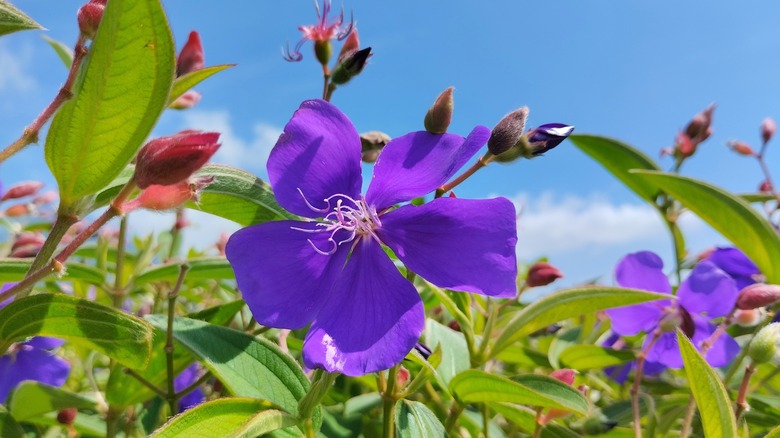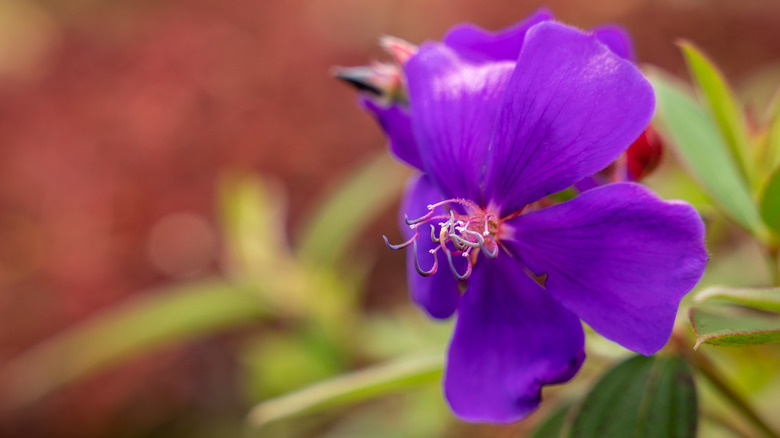The Royal Flower Hummingbirds Will Enjoy Having In Your Garden
Hummingbirds are like tiny, winged gems that zip through the air, prepared to adorn the proper floral crown at a moment's notice, and there is one royal blossom for which this dainty bird will loyally serve — the princess flower. Also known as the glory bush or scientifically, the Tibouchina urvilleana, the princess flower is an evergreen, tropical shrub with Brazilian roots. The noble, purple flowers that grow along its panicles are attractive to bees and butterflies alike, as well as to hummingbirds.
Understanding that this shrub is partial to warm environments is key to its care if you plan to grow it yourself. The plant's native tropical climate plays a role in the princess flower's light, soil, and water requirements. Meanwhile, the shrub's growth habit is extremely versatile and needs to be maintained by pruning. It can be grown as a small, ornamental tree or trained to grow along a trellis or wall. Pruning the princess flower at specific times throughout the year will encourage floral abundance and shape it into a heavenly hub for a hummingbird-friendly flower garden.
Why you should add the princess flower to your hummingbird garden
Hummingbirds will flutter to your garden when the princess flower is in sight thanks to its versatile growth habit and long blooming period. Hummingbirds enjoy shrubs, trees, and vines. The princess flower can be all three! The plant's various growth habits appeals to the different needs of hummingbirds. As a shrub, the princess flower provides dense protection from predators. When transformed into an ornamental tree, princess flower gives hummers extra shade to cool off. Meanwhile, as a vine, princess flower offers endless opportunities to perch after the birds zip around the neighborhood.
Hummingbirds benefit from having access to blooming flowers year-round. While the majority of the princess flower blossoms appear from May to January, this is still quite an extended time for flowers to remain available for the birds. If you live in a climate with warm winters, this tropical plant can actually grow quite large to provide more blooms throughout the year. Couple this royal blooming flower with other tricks to attract more hummingbirds to your garden and you'll always have the quick-winged birds around.
Caring for the princess flower
Growing the princess flower to attract hummingbirds to your garden means being mindful of the plant's tropical origins. The princess flower thrives in moist, acidic, and well-drained soil. In the first week of planting, water newly established princess flowers every other day. After a few weeks, water 1 inch per week. Princess flower is hardy to USDA zones 9a to 11b, where winters are warmer. In zone 8, outdoor-grown princess flowers die back to the ground in the winter. Underground, the roots remain dormant until the plant grows again in the spring. Consider protecting the roots before your first frost date in the fall if you live in zone 8. Add a layer of mulch to warm the soil and insulate the roots until the plant revives. Alternatively, those in zones cooler than zone 8 can grow the plant in a container, allowing you to bring it indoors, until warm temperatures return.
Throughout the growing season, the plant blooms best in full sun, upward of six hours daily. However, princess flower can also fare well in partial shade. It's recommended to prune the plant to maintain its growth, especially if training it to grow as a tree. Pinch back new growth on the plant to encourage branching that enhances floral display and provides a sturdy foundation for the trunk. Multiple times a year, identify dormant buds and prune just above these at ⅓ of an inch.


